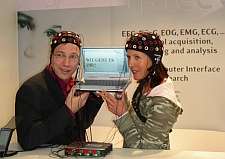Despite advances in computer graphics, few people would think virtual characters or objects are real. Yet placed in a virtual reality environment most people will interact with them as if they are really there. European researchers are finding out why.
In trying to understand presence - the propensity of humans to respond to fake stimuli as if they are real - the researchers are not just gaining insights into how the human brain functions. They are also learning how to create more intense and realistic virtual experiences, opening the door to myriad applications for healthcare, training, social research and entertainment.
“Virtual environments could be used by psychiatrists to help people overcome anxiety disorders and phobias... by researchers to study social behaviour not practically or ethically reproduced in the real world, or to create more immersive virtual reality for entertainment,” explains Mel Slater, a computer scientist at ICREA in Barcelona and University College, London, who led the team behind the research.
Despite advances in computer graphics, few people would think virtual characters or objects are real.
Working in the EU-funded Presenccia project, Slater and his team, drawn from fields as diverse as neuroscience, psychology, psychophysics, mechanical engineering and philosophy, conducted a variety of experiments to understand why humans interpret and respond to virtual stimuli the way they do and how those experiences can be made more intense.
For one experiment they developed a virtual bar, which test subjects enter by donning a virtual reality (VR) headset or immersing themselves in a VR CAVE in which stereo images are projected onto the walls. As the virtual patrons socialise, drink and dance, a fire breaks out. Sometimes the virtual characters ignore it, sometimes they flee in panic. That in turn dictates how the real test subjects, immersed in the virtual environment, respond.
Panic and pain... virtually
“We have had people literally run out of the VR room, even though they know that what they are witnessing is not real,” says Slater. “They take their cues from the other characters.”
In another instance, the researchers re-enacted controversial experiments conducted by American social psychologist Stanley Milgram in the 1960s that showed people’s propensity to follow orders even if they know what they are doing is wrong. Instead of using a real actor, as Milgram did, the Presenccia team used a virtual character to which the test subject was instructed to give progressively more intense electric shocks whenever it answered questions incorrectly. The howls of pain and protest from the character, a virtual woman, increased as the experiment went on.
“Some of the test subjects felt so uncomfortable that they actually stopped participating and left the VR environment. Around half said they wanted to leave, but said they did not because they kept telling themselves it wasn’t real,” Slater says.
All had physical reactions, measured by their skin conductivity, perspiration and heart rate, showing that, at a subconscious level, people’s responses are similar regardless of whether what they are experiencing is real or virtual. The plausibility of the events enhances the sense that what is happening is real. Plausibility, Slater says, is therefore more important to presence than the quality of the graphics in a VR environment.
For example, when a test subject was made to stand on the edge of a virtual pit, staring down at an 18-metre drop, their level of anxiety increased if they could see dynamically changing shadows and reflections of their virtual body even if the graphics were poor. In other experiments, the researchers made people believe that a virtual hand was their own - replicating in VR the so-called “rubber hand illusion” - or that they were looking at themselves from another angle, creating a kind of out-of-body experience. In one trial, they even gave male test subjects a woman’s body.
Help with phobias and paranoia
By understanding what makes people perceive virtual objects and experiences to be real, the researchers hope to create applications that could revolutionise certain psychiatric treatments. Patients with a fear of spiders or heights, for example, could be exposed to and helped to overcome their fears in virtual reality. Similarly people who are shy or paranoid about public speaking could be helped by having to face virtual people and crowds.
“One application we are working on is designed to help shy men overcome their fear of meeting women by making them interact with a virtual woman,” Slater says.
The technology is also being used for social research which, much like the Milgram experiments, would not be practical or ethical to conduct in the real world. One experiment due to be run at University College, London, will use a virtual environment to study how people respond to violence in public places, such as a bar fight between football hooligans.
Besides healthcare and research, more immersive VR would also help in training, potentially greatly improving the results of flight or driving simulators. Slater also envisions VR environments being used to train people to use prosthetic limbs and wheelchairs through mind control before trying them out in the real world. A brain-computer interface (BCI) developed for just such a purpose was tested in the Presenccia project and in a similarly named predecessor called Presencia, which received funding under the EU’s Sixth and Fifth Framework Programmes for research, respectively.
Though immersive VR is likely to have many applications in healthcare, research and training, the biggest market is probably entertainment. With the cost of VR technology coming down, people could eventually be exploring virtual worlds and interacting with virtual characters and other people through VR rooms in their homes akin to the “holodecks” seen in Star Trek, Slater says.
More information:
Presenccia project: www.presenccia.org/
Read also: A (virtual) smart home controlled by your thoughts
Provided by ICT Results




















